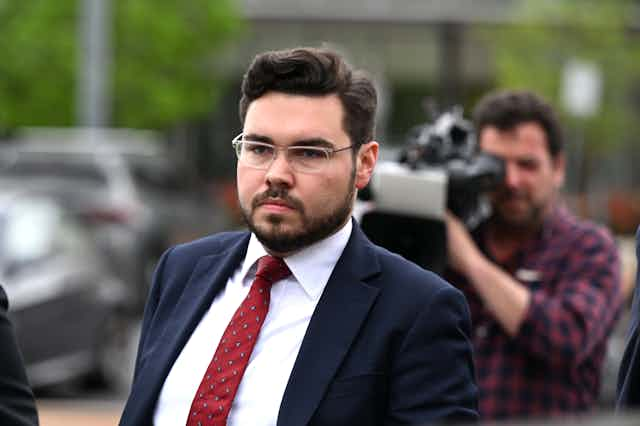The trial of Bruce Lehrmann, accused of raping former Liberal Party staffer Brittany Higgins, has been aborted after a juror was found in possession of material that had not been presented as evidence, against the judge’s specific directions.
This was not the first drama in the jury’s deliberations. On Tuesday, after more than four days of deliberating, the 12 jurors passed a note to ACT Chief Justice Lucy McCallum saying they could not agree on a unanimous verdict. The judge called the jurors back into the courtroom and encouraged them to keep working on a decision.
Today, however, she announced she had no choice but to discharge the jury due to a juror’s “misconduct”, which was apparently discovered when a member of the court staff noticed an academic research paper in one of the juror’s document holders that had been knocked to the floor.
Is this uncommon?
It’s not uncommon for juries to be discharged in circumstances where a juror decides to do their own unauthorised research, such as by photographing a crime scene, making their own enquiries, or planning to visit a place mentioned in evidence.
One of the more extraordinary cases of jury misconduct occurred in 1994 when a number of jurors in Britain deployed a ouija board to contact the victim of a murder. A new trial was ordered.
Interestingly, misconduct often comes to light when one juror approaches the judge about a fellow juror’s behaviour. It’s more difficult to know how common it is for extraneous research by a juror to go undetected, particularly given the veil of secrecy that surrounds jury deliberations.
In today’s hyper-connected world, it’s easy for a juror to access information, in this case an academic paper about the incidence of false complaints of rape.
Why are jurors not allowed to conduct their own research?
The role of the jury is to come to a decision based on the evidence before them. Juries are community representatives within the courtroom, whose job it is to determine questions of fact and apply the law to those facts to reach a verdict.
One might think that, in so doing, it’s inevitable individual jurors bring with them their own life experiences and moral values, and there is nothing wrong with that. Indeed, Justice McCallum told the jury in this case:
You are expected to use your common sense […] your understanding of human nature and your ability to judge people […] You are entitled to have regard to your understanding and experience of the nature of memory.
However, the jurors in the trial of Lehrmann sat through days of evidence, carefully presented and argued over by prosecution and defence counsel, and deemed admissible according to the rules of evidence.
The most important rule of admissibility is that the evidence is relevant to the case. Beyond relevance, evidence is subject to complex rules of admissibility, designed primarily to screen out material that’s unfairly prejudicial to the defence, and to protect vulnerable witnesses.
Examples include rules against the admission of hearsay, prior sexual experience of a complainant, or the “character” of a defendant. These rules are all the more important when it comes to emotive crimes like rape.
Given the complex nature of some of the evidence with which they are presented, and the “holes” in the trial narrative that might appear from the exclusion of potentially relevant evidence, jury members may be tempted to turn to outside sources in an attempt to increase their understanding of issues raised during the course of a trial.
The dangers of allowing such extraneous “research” are twofold. First, such evidence is not subject to the rules of admissibility alluded to above. Second, it is not subject to the rigours of cross-examination.
For these reasons, jurors are reminded again and again to come to a decision based solely on the evidence presented. It’s for this reason the jury in this case will have been instructed to disregard anything they may have read, heard or seen in the media about the case before they had been empanelled, and certainly not to undertake their own research.
What happens next?
The trial has been aborted and the jury has been dismissed. The judge granted Lehrmann bail until February 20, and set that as a provisional retrial date. The matter is now referred back to the Director of Public Prosecutions, Shane Drumgold. It’s a matter for him, ultimately, to determine whether to proceed with a retrial.
A retrial comes at considerable economic cost. What’s more, all of the witnesses will now be put through the same ordeal once again.
Despite the disruption caused by the errant juror’s behaviour, however well-meaning, the juror has committed no offence in the ACT. However, other jurisdictions deem juror contempt a serious criminal offence.
It remains to be seen what the next chapter in this protracted case brings.
Correction: this article previously stated that it’s unclear whether a retrial will be heard before a jury. This has been removed. ACT law requires the charge of “sexual intercourse without consent” to be heard before a jury.

